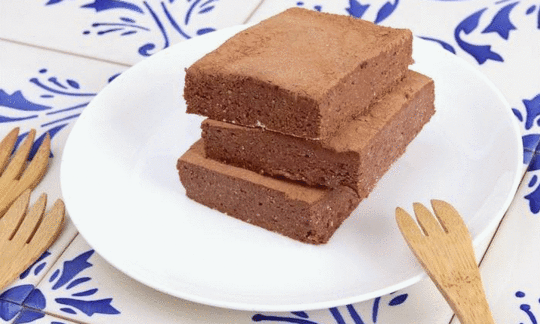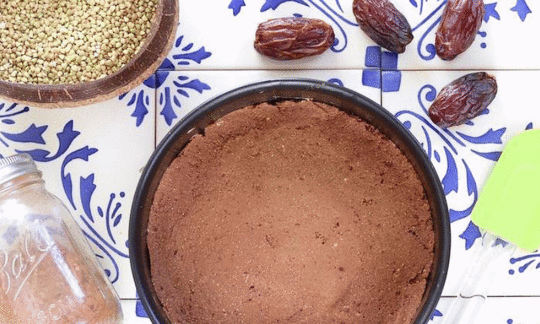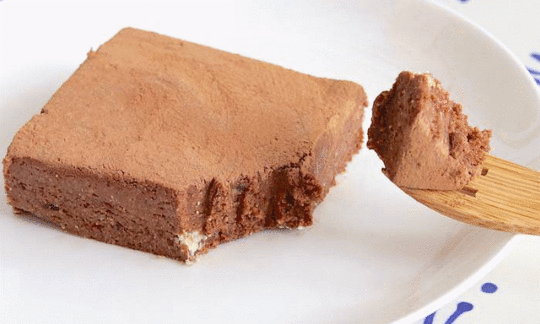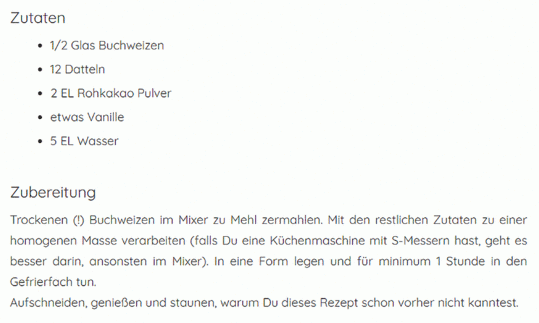Raw vegan brownies with buckwheat - without oil and gluten
raw-vegan
Ingredients (for servings, )
| 5 ½ oz | Buckwheat, raw (organic?) |
| 12 | Dates, Medjool variety, pitted, raw? (organic?) (10 oz) |
| 2 tbsp | Cocoa powder, unsweetened (raw?, organic?) (0.38 oz) |
| 5 tbsp | Drinking water, raw (organic?) (1.0 oz) |
| ½ | Vanilla pod (also Bourbon vanilla, organic?) (0.05 oz) |
Equipment
- hand-held blender / immersion blender or food processor
- refrigerator or freezer
- baking pan (springform pan)
- coffee grinder, electric
Type of preparation
- chop or grind
- food preparation without heating
- blend
- cool
Preparation
Grind dry (!) buckwheat into flour in a coffee grinder. Add pitted dates together with cocoa and vanilla and grind again.
The original recipe does not specify the amount of vanilla. In addition, ½ glass of buckwheat is used for 8 portions.
Author's note: A food processor with an S-blade works well, otherwise use a blender.
Self-experiment: We tried the recipe and pureed the dates and water with a hand blender. Then mixed in the ground buckwheat with vanilla and cocoa powder with a fork. We doubled the amount of water and added 2 tablespoons of raw lucuma powder for flavor.
Add water and mix with a fork or in a blender until smooth.
You may need a little more water to make the dough into a mass. In our own experiment, we even doubled the amount.
Pour the dough into a mold (see second picture) and place in the freezer for at least 1 hour.
Cut and enjoy.
A springform pan with a diameter of approx. 20 cm (Ø) is ideal for 8-10 portions.
A refrigerator is also sufficient. The process is simply a little quicker in a freezer or freezer compartment.
|
Nutritional Information per person
Convert per 100g
|
2000 kcal | |
|---|---|---|
| Energy | 172 kcal | 8.6% |
| Fat/Lipids | 0.92 g | 1.3% |
| Saturated Fats | 0.26 g | 1.3% |
| Carbohydrates (inc.dietary fiber) | 42 g | 15.6% |
| Sugars | 24 g | 26.7% |
| Fiber | 5.0 g | 19.8% |
| Protein/Albumin | 3.6 g | 7.1% |
| Cooking Salt (Na:1.0 mg) | 2.6 mg | 0.1% |
| Essential micronutrients with the highest proportions | per person | 2000 kcal | |
|---|---|---|---|
| Min | Copper, Cu | 0.40 mg | 40.0% |
| Min | Manganese, Mn | 0.43 mg | 21.0% |
| Elem | Magnesium, Mg | 73 mg | 19.0% |
| Elem | Potassium, K | 364 mg | 18.0% |
| Prot | Tryptophan (Trp, W) | 0.04 g | 18.0% |
| Elem | Phosphorus, P | 102 mg | 15.0% |
| Prot | Threonine (Thr, T) | 0.13 g | 14.0% |
| Vit | Niacin (née vitamin B3) | 2.0 mg | 13.0% |
| Prot | Valine (Val, V) | 0.18 g | 11.0% |
| Vit | Vitamin B6 (pyridoxine) | 0.13 mg | 10.0% |
Detailed Nutritional Information per Person for this Recipe
The majority of the nutritional information comes from the USDA (US Department of Agriculture). This means that the information for natural products is often incomplete or only given within broader categories, whereas in most cases products made from these have more complete information displayed.
If we take flaxseed, for example, the important essential amino acid ALA (omega-3) is only included in an overarching category whereas for flaxseed oil ALA is listed specifically. In time, we will be able to change this, but it will require a lot of work. An “i” appears behind ingredients that have been adjusted and an explanation appears when you hover over this symbol.
For Erb Muesli, the original calculations resulted in 48 % of the daily requirement of ALA — but with the correction, we see that the muesli actually covers >100 % of the necessary recommendation for the omega-3 fatty acid ALA. Our goal is to eventually be able to compare the nutritional value of our recipes with those that are used in conventional western lifestyles.
| Essential fatty acids | per person | 2000 kcal |
|---|---|---|
| Linoleic acid; LA; 18:2 omega-6 | 0.20 g | 2.0% |
| Alpha-Linolenic acid; ALA; 18:3 omega-3 | 0.02 g | 1.0% |
| Essential amino acids | per person | 2000 kcal |
|---|---|---|
| Tryptophan (Trp, W) | 0.04 g | 18.0% |
| Threonine (Thr, T) | 0.13 g | 14.0% |
| Valine (Val, V) | 0.18 g | 11.0% |
| Isoleucine (Ile, I) | 0.13 g | 10.0% |
| Leucine (Leu, L) | 0.21 g | 9.0% |
| Lysine (Lys, K) | 0.17 g | 9.0% |
| Phenylalanine (Phe, F) | 0.13 g | 9.0% |
| Methionine (Met, M) | 0.04 g | 5.0% |
| Vitamins | per person | 2000 kcal |
|---|---|---|
| Niacin (née vitamin B3) | 2.0 mg | 13.0% |
| Vitamin B6 (pyridoxine) | 0.13 mg | 10.0% |
| Pantothenic acid (vitamin B5) | 0.54 mg | 9.0% |
| Riboflavin (vitamin B2) | 0.11 mg | 8.0% |
| Folate, as the active form of folic acid (née vitamin B9 and | 12 µg | 6.0% |
| Thiamine (vitamin B1) | 0.04 mg | 4.0% |
| Biotin (ex vitamin B7, H) | 1.0 µg | 2.0% |
| Vitamin K | 1.0 µg | 1.0% |
| Vitamin A, as RAE | 2.6 µg | < 0.1% |
| Vitamin E, as a-TEs | 0.00 mg | < 0.1% |
| Essential macroelements (macronutrients) | per person | 2000 kcal |
|---|---|---|
| Magnesium, Mg | 73 mg | 19.0% |
| Potassium, K | 364 mg | 18.0% |
| Phosphorus, P | 102 mg | 15.0% |
| Calcium, Ca | 31 mg | 4.0% |
| Sodium, Na | 1.0 mg | < 0.1% |
| Essential trace elements (micronutrients) | per person | 2000 kcal |
|---|---|---|
| Copper, Cu | 0.40 mg | 40.0% |
| Manganese, Mn | 0.43 mg | 21.0% |
| Iron, Fe | 1.0 mg | 7.0% |
| Zinc, Zn | 0.73 mg | 7.0% |
| Selenium, Se | 1.9 µg | 3.0% |
| Fluorine, F | 2.6 µg | < 0.1% |
| Iod, I (Jod, J) | 0.11 µg | < 0.1% |
These gluten-free, raw vegan brownies with buckwheat and dates not only do not require any oil, but are also quick and easy to prepare.
Portion size: We have calculated the amount given for 8 portions. However, this only corresponds to our own perception.
Nutrient profile: According to GDA guidelines, one portion of brownies covers 40% of the average daily requirement of copper. It also covers around 20% of the requirement of manganese and magnesium. With just 172 kcal per portion, these brownies are comparatively low in calories.
Buckwheat: Buckwheat is a so-called pseudocereal, a plant species that is not a grass, but can be used in a similar way to cereals but is gluten-free. Its origins lie in Central and East Asia, where it is still widely used today, for example in the form of soba noodles (noodles made from buckwheat flour) in Japan. It can be used raw as a grain mix for muesli (e.g. pea muesli), for cakes like this, as buckwheat crunch or cooked in soups and patties. It also has a high biological value (measure of conversion into the body's own proteins).
Cocoa powder: In addition to its high fat content, cocoa also contains a variety of different and sometimes valuable ingredients. The secret of unsweetened cocoa powder in raw food quality lies in its gentle production and the natural fermentation process. The decomposition of the cocoa bean pulp occurs naturally, without a roasting process.
Dates: The date fruit with its honey-like sweet taste is actually a berry fruit. It is rich in vitamin B6 and the minerals copper and potassium. It also contains more fiber than conventional wholemeal bread.
Vanilla pod: Vanilla is usually found in stores under the name Bourbon vanilla. Strictly speaking, the pods themselves are not raw food. The reason for this is the complex processing, in which the pods are blanched before the fermentation process that gives them the aroma.
Storage and sweetness of dates: Dried dates keep well for up to a year. If stored for longer, they continue to dry out and eventually begin to crystallize, increasing their sweetness and giving them a crunchy, soft consistency. Dried dates have a fairly high glycemic index of almost 100 and should therefore always be consumed with caution. However, compared to sugary treats, they are certainly the healthier alternative.
More sweetness: The brownies prepared as above have a slightly bitter note due to the cocoa powder. If you like it sweeter, you can increase the amount of dates or even double it.
Raw food: Since vanilla is not strictly speaking a raw food, you can leave it out.
Self-experiment with lucuma powder: We tried the recipe and pureed the dates together with the water using a hand blender. Then we mixed in the ground buckwheat together with vanilla and cocoa powder using a fork. We doubled the amount of water and added 2 tablespoons of raw lucuma powder for flavor. This gives it a slightly fruitier note.









